Honda’s S600 Was Tiny, but It Left a Mark
With a new world record sale on Bring A Trailer of $109,200 including fees, the Honda S600 has officially entered the hall of collectible Japanese legends. The 1965 roadster in question had an exceptional pedigree: A comprehensively restored example that won best in show at the 2014 Japanese Classic Car Show in Long Beach, California, it had also been displayed at The Petersen Automotive Museum. But all S600s are special: effervescent to drive, advanced for their time, and of outsized historical importance.
The diminutive S600 casts a long shadow. Not only was it the first production car exported by the brand, but the coupe also was developed in a way that speaks to the speed with which Honda was reacting to the rapidly changing automotive industry in Japan. Launched in 1964, the design of the S600 is impressive even today: fully independent suspension at all four corners, a curb weight of under 1600 pounds, and an all-aluminum, 606cc four-cylinder engine with a redline of 9500 rpm and a power output of nearly 100 hp per liter.
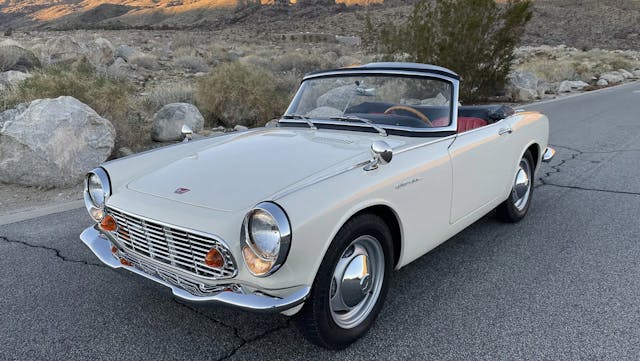
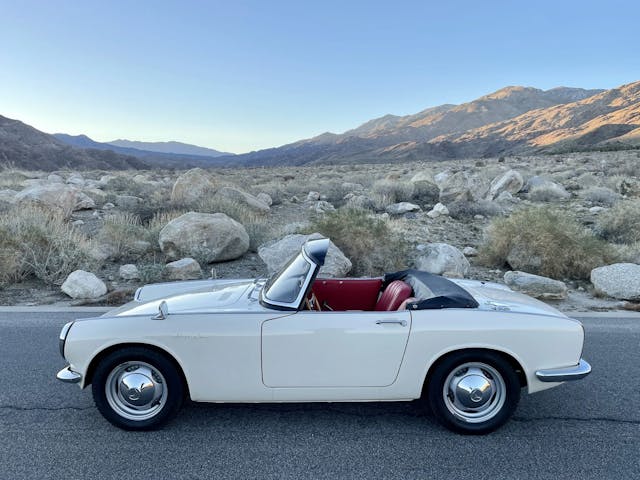

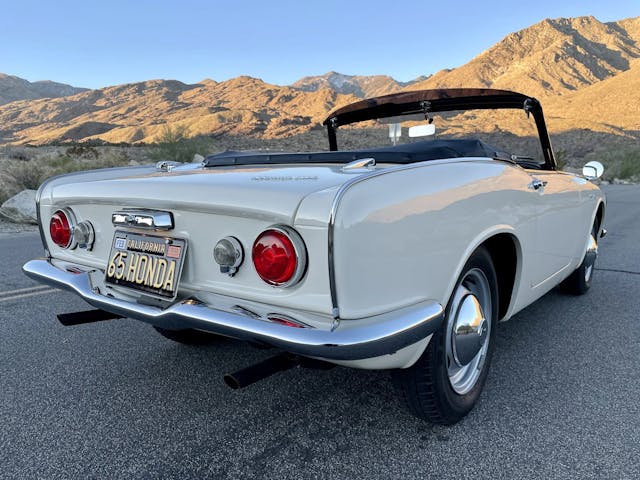
In its day, the S600 should have shocked the world with its capability. But this was the mid-1960s, long before the fuel crises of the ’70s would send buyers flocking to Honda dealerships. Though fictional, the Mad Men episode “The Chrysanthemum and the Sword” captures the sense of the bemusement with which U.S. buyers must have received an export-specification S600: His firm having won the chance to compete for Honda’s planned automotive business, Roger Sterling mentions the sky-high redline of the little Honda, a figure to which Don Draper responds with, “What?” The S600 is dismissed as more motorcycle than car.
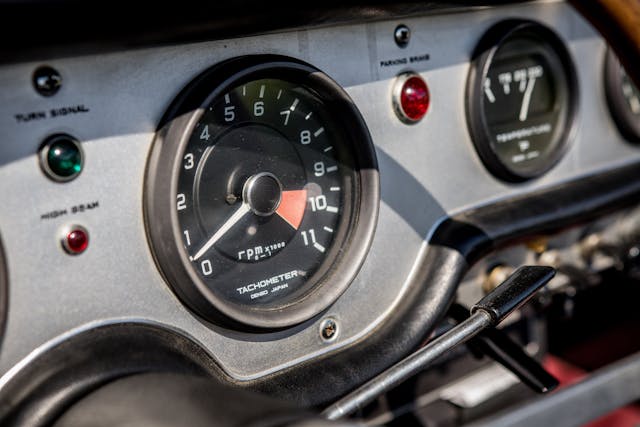
But that is the importance and the appeal of this tiny roadster: It is the bridge between Honda’s early motorcycle success and the brand’s ascendancy as an automaker. At the same time, S600 embodies the mercurial nature of Soichiro Honda, the founder of the company. The sports coupe wasn’t the first passenger vehicle produced by Honda. With most of Japan’s population getting around via bicycle or train in the 1960s, the company first built the T360, a tiny but practical pickup truck. Dr. Honda, however, wanted more.

A longtime racing fan even before WWII, Soichiro wanted Honda to build a sports car. Shown next to the T360 in 1962, the S360 prototype roadster was a bold effort. The color of its paint involved a rather public fight: Honda wanted his first sports car to wear bright red. At the time in Japan, red and white were reserved for emergency vehicles. Soichiro wrote newspaper columns about how ridiculous this restriction was and generally made such a nuisance of himself that the Japanese government relented. The production version of the S360, the S500, launched in a bright crimson that remains Honda’s official corporate color.
You could call the S500 a production car, but with just over 1300 made, it’s as rare as a Ferrari F40. The S500 also suffered from various mechanical issues due to the high-strung nature of its quad-carbureted 531cc engine, which made 44 hp at 8000 rpm. After a year, the S600 arrived with a bored-out, 57-hp version of the same engine, now supported by reworked cooling and oiling systems.
Honda’s sports car wasn’t perfect yet. In the summer of 1964, journalist and founder of Japan’s Car Graphic publication Shotaro Kobayashi bought a brand-new S600 and shipped it to Europe. The official purpose of the trip was for Kobayashi to attend Honda’s first foray into Formula 1, at the Nürburgring, but he also turned the expedition into a 7500-mile tour of all things automotive in Europe. Kobayashi hit up Monza and Spa, crossed over the Alps, stopped in at the Porsche factory to see the then-new 901 (later 911), and even managed to let Colin Chapman have a go in the S600.
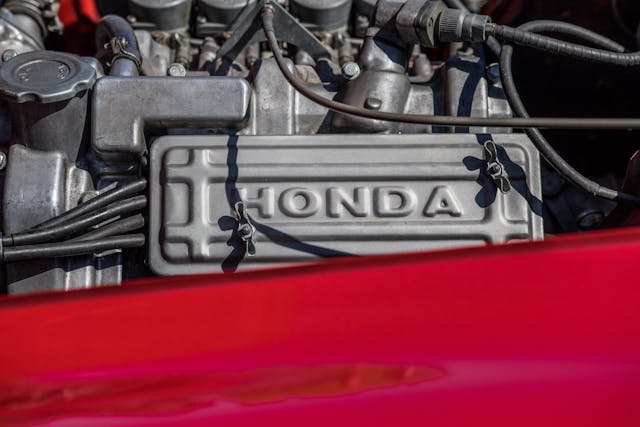
On the way back from the German Grand Prix, disaster struck. Piston three seized and the connecting rod went through the block. The culprit was a torn hose leading to one of the four Keihin carburetors. Luckily Honda just so happened to have a replacement engine in Belgium. (Rumor has it that Honda was so worried about the failure of Kobayashi’s well-publicized trip that the company had a car tucked away, on standby.) A reinforcement was applied to all subsequent production cars to prevent this tearing.
Honda built roughly 11,000 S600s between 1964 and 1966, with periodic revisions for greater reliability. Each one had that 9500-rpm, four-cylinder hummingbird of an engine, and vestigial motorcycle features like twin chain drives, one for each independently sprung rear wheel.
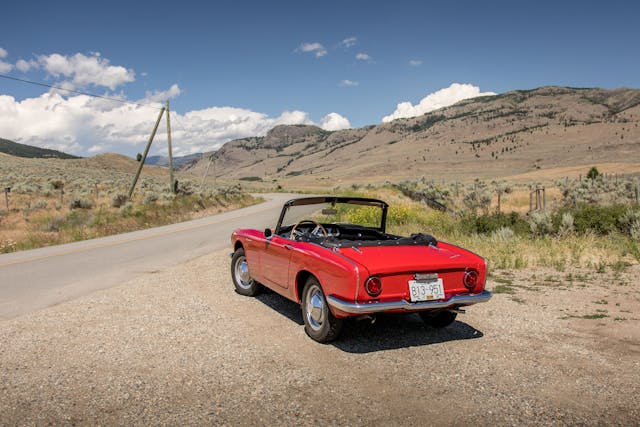
On the road, the main experience is a lack of inertia. If properly set up and tuned—something perhaps best left to a motorcycle mechanic—the four-cylinder engine doesn’t so much crank as it does switch on like a modern Honda generator. The curb weight is near that of a Lotus Elan, although the suspension is a little softer. The brakes are drums at all four corners, but shedding speed is easy with so little weight on the move.

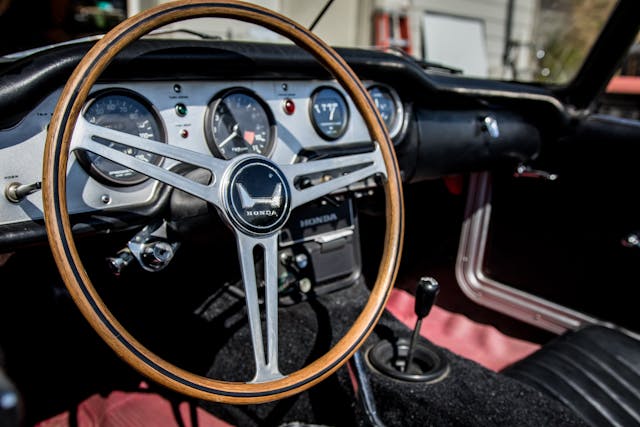
Recalibrating your brain to the sky-high rev range takes some getting used to. The tendency is to short-shift at 7000 or even 8000 rpm; to have the most fun, you learn to keep your foot in it. Placing the car on the road is ridiculously easy, as it’s ten inches narrower than an original Miata, and anyone over six feet tall will loom out of the cockpit like one of Richard Scarry’s anthropomorphic bears driving a shoe car. Everything in a S600 smells and looks like the 1960s, but the car drives as you hope it will: like something far more modern.
The temptation is to liken the S600 to the equally revvy S2000, but you have to put both cars in context. The 21st-century screamer is the product of a fully mature Honda, a company that was still pushing the engineering envelope, but one that had an established global market share and broad product portfolio to back it up. The S600 was breathtakingly audacious in its time, and the way it screams through those quad-carbs near redline lets any S2000 know that Grandpa Honda is not one for a quiet retirement.
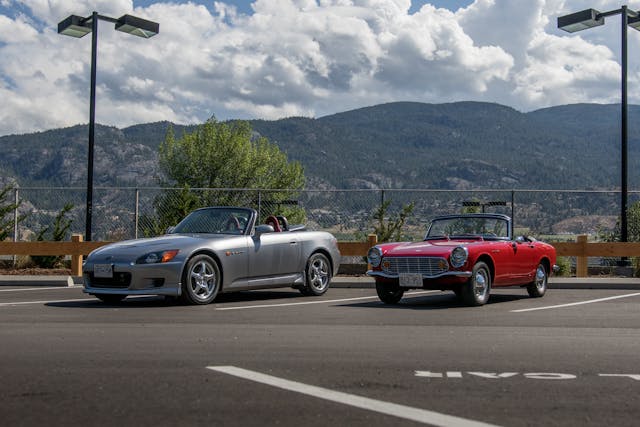
Soichiro’s follow-up to the S600 was the larger, front-wheel-drive Coupe 9, which ended up being a bit of a disaster in terms of company morale. The boss kept changing the car on the production line, and the engineers eventually rebelled. The later N600 hatchback (and of course the Civic), which was most Americans’ introduction to four-wheeled Honda products, was a lot more practical and easy to live with day-to-day.
S600s did make their way outside of Japan, arriving in Europe as official exports, and also into Canada. Canadian cars were sold through motorcycle dealers, and the first batch was likely shipped to Toronto in the summer of 1965. S600s are not common in Canada by any means, but since keeping one on the road requires some pretty skilled mechanical knowledge, and because parts were hard to come by in the pre-internet age, barn finds are not unheard of.
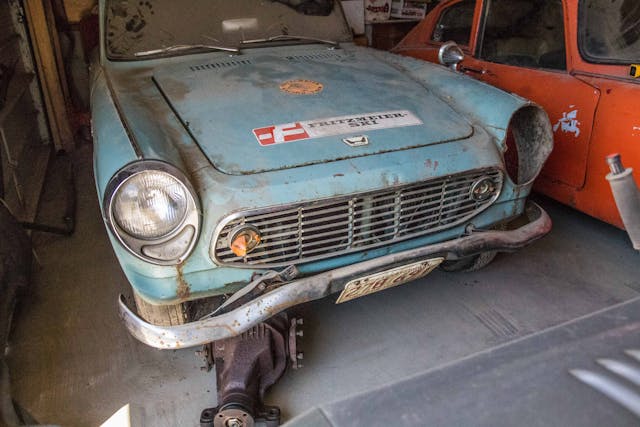
The other way to get into a left-hand-drive S600 is via Okinawa, which remained under U.S. administration until the late 1970s. There, unlike in mainland Japan, cars drove on the right side of the road. There’s also a strong following for the S600 in Germany, buoyed by specialists like Michael Ortmann.
Arguably, the S800 that followed the S600 is an easier collectible to own and keep on the road: Later models ditched the rear chain drives for a more conventional axle. You can also get a later S800 with disc brakes up front, although you can also fit the discs to an earlier S600.
With values solidly established, bagging a bargain S600 is probably off the table these days. Finding and restoring one is a theoretically more accessible path, but these little cars are so delicate and precise that a lot of patience is required. The S600 might be the grandfather of the Honda Civic, but it’s not a Honda Civic.
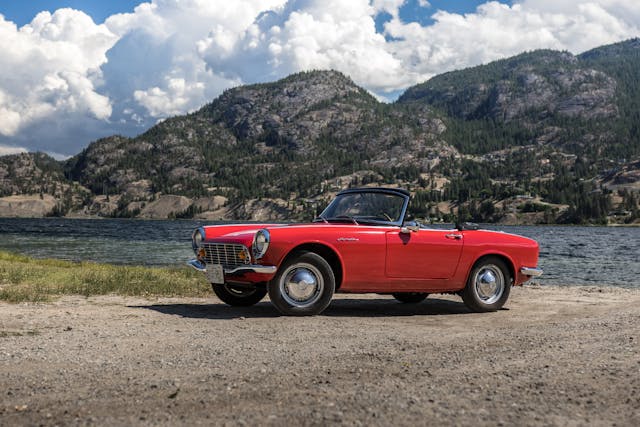
Against contemporary Japanese icons of the 1960s, the S600 punches well above its weight. It is less outlandish than the Mazda Cosmo, thought the Honda equals its Japanese compatriot for technological advancement. An S600 is nowhere near as rare and expensive as a Toyota 2000GT but shares its elegance and restraint.
The S600 offers a genuinely unique driving experience, a thrill that is laced with Soichiro’s maverick glee for speed. Six decades later, the coupe is a clear link in the bloodline running between the Super Cub and the NSX. The first car Dr. Honda sent out into the world may have been tiny, but it left a mark.

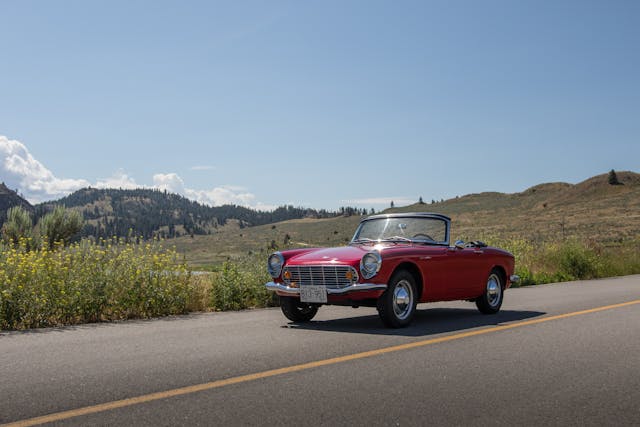
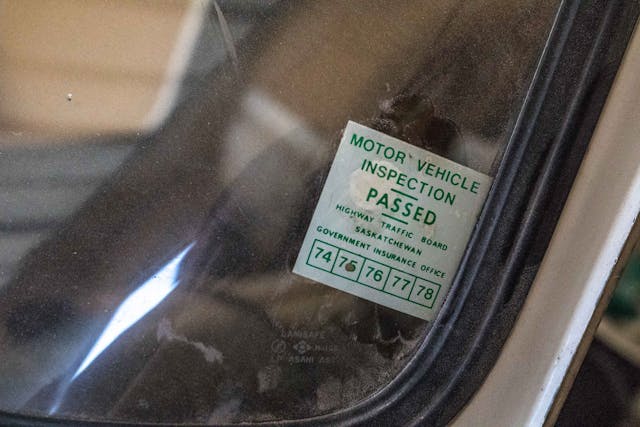
***
Check out the Hagerty Media homepage so you don’t miss a single story, or better yet, bookmark it. To get our best stories delivered right to your inbox, subscribe to our newsletters.
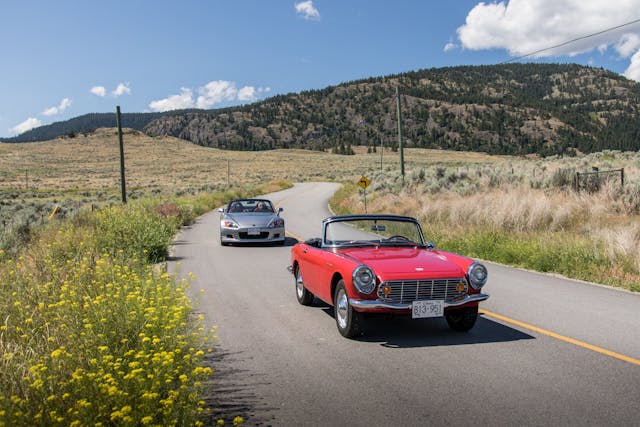


Brendan–you have all the incorrect photos in your story. None of the photos are of the S600 that sold this week on bring a trailer and it’s very confusing. You might want to replace the photos with ones from the auction so you are depicting the correct vehicle.
Hi Sandy,
Brendan used this week’s sale as a means to introduce the relevance of the model more broadly. We’ve added some photos of the record car up top so people can see that one before delving into the S600’s interesting history. —Eddy
These really were more motorcycle vs car. The rear wheels were chain driven. No axle just a chain drive.
Not true. There was a drive shaft (prop shaft) that connected to a solid rear axle by means of a conventional differential. This was mounted to the car’s frame and then a chain drive connected each end of the axle to each respective wheel. This allowed independent movement of the rear wheels. As the author correctly pointed out, the subsequent S800 used a conventional live rear axle instead.
It’s …cute, in a good way. Seeing that ” warning Will Robinson danger ! ” zone on the tach at 9 five is certainly different than most especially for a car of this age. Even with having Hondas higher rpm motorcycle engine expertise behind it, I’d probably be getting nervous near 8. With the cost and I’m guessing there aren’t many ‘rebuilt and ready, shipped to your door’ options out there. But it might be fun having people watch you crawl underneath it with the chain lube. What’s the manufacturers suggested on that anyway?
I remember a couple in wrecking yards in the early ‘70s… I think the chain was in an oil bath.
I had an S600 coup. Yes the chains were in a closed oil bath. It was one of the most fun cars to drive I’ve ever had. 9500 was spectacular, you felt like you were in an F1 car until you looked at the speedo and realized you were hardly moving. The handling was great, the radio was beyond most cars of the day, no set buttons, you pushed the button and it would seek out the next station. We blow up the clutch, a wet multi plate unit. None to be found locally, phoned Honda in Japan. 3 days later one arrived with instruction on how to change it, for free. Great article, well done.
Fun cars but I really miss the S2000. Don’t think we will get it’s equal again from Honda.
I have owned a 1966 SM600 (while stationed in Japan) and a 2002 S2000 AP1. The unique drive system of the SM600: drive shaft to differential, axels to chain housing connected to small sprocket in the housing with the chain to a larger sprocket driving the rear wheels. You would periodically check the chain tension via an external lever on the housing. The high rev engine kept you in 2nd gear on local roads, but when you could find an open country road, wind it up to around 8K through 3rd gear. Not fast, but great handling for its time. Then, many years later, comes the S2000. So refined, yet not overdone. Loved the sweet high rev engine paired with the amazing short throw 6 speed. Power when you needed it and outstanding handling.
Back in my college days in the 1960s,I was driving through a small town in Louisiana on my way to Dallas, Texas, when I spotted an S600 parked outside a used-car dealer’s store. The car was brand-new and for sale. I expressed interest in buying it and got the dealer to let me drive the car. It was fantastic, with the astronomical red line providing a completely out of context soundtrack to a leisurely pace. But the car was fun to drive. I didn’t buy it, though. Couldn’t have afforded it. Many years later, I saw another S600 in a children’s museum. It looked to be in excellent condition, with some minor wear and tear from kids playing in and on it. I thought about offering to buy it, but never did and now the museum is no longer there. Maybe I will try to find out what happened to the car…
Looks like a Gold Wing six would easily fit. Not as rev happy but twice the power. Different but the same. And that Gold Wing trans already has reverse so and it’s shaft drive instead … an S600/6 ?
I believe Caanadian sales started in western Canada, not in Toronto. They were imported by Trevor Deeley, Honda’s first international motorcycle distributor, whose territory included British Columbia to Manitoba. Deeley saw the cars on a visit to the factory in 1964 to look at the latest bikes. The story goes that he thught he could do someting with the cars. Every motorcycle dealer in his network received one or two. Many motorcycle dealers of that time were operating out of premises that could not service cars, even small ones, and were not interested in selling them, Many years ago I tried to find out how many S600s had entered western Canada but was unsuccessful, and I think this number is now unobtainable.
Awesome little car that was ahead of its time.
Wish I would have gotten an S2000 instead of the Sky Redline back when I was considering them both. Always like Honda’s. Had 2 of their motorcycles, a CB650 & a ST1100 that I still have. Quality machines.
My son has a pair of S800’s, a coupe and a roadster. And yes they have live rear axels and front disk brakes. They are both “project” cars and he will probably list them on either Hagerty or BAT auction sites and let someone else bring them back to life.